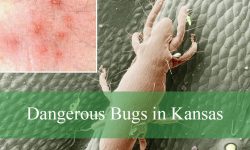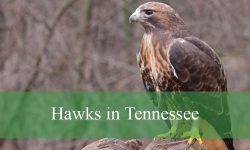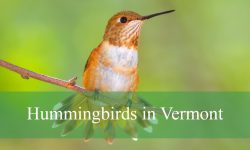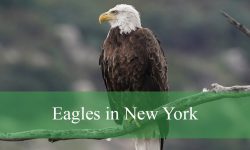Utah’s varied terrain offers the perfect environment for many squirrel species to thrive. From mountain forests to rocky canyons, these animals are active and visible year-round.
Each type of squirrel has unique features and behaviors. Some glide through treetops, others dig burrows or chatter from the branches. Learning to identify them makes outdoor exploration even more enjoyable.
This article introduces 10 squirrels you can find in Utah. With pictures and clear descriptions, you’ll know what to look for and where to find each one.
Common Squirrels Found in Utah
Rock Squirrel (Otospermophilus variegatus)
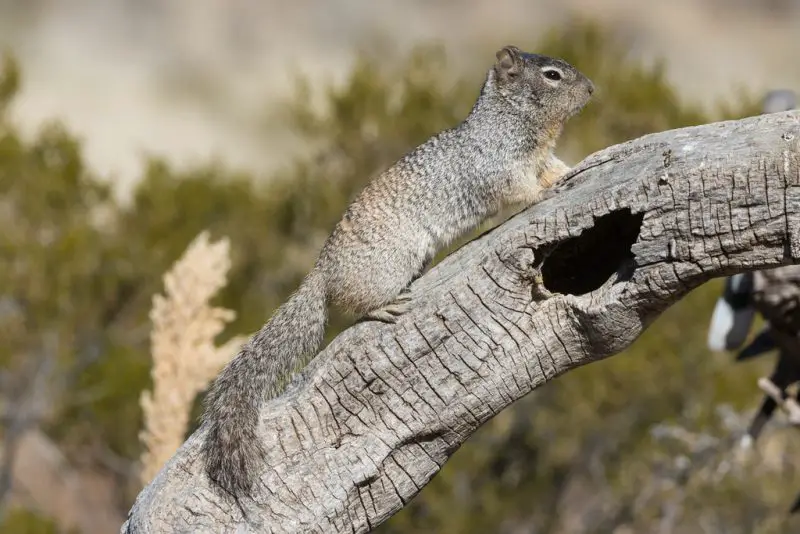
The Rock Squirrel is one of the most common and widespread ground squirrels found throughout southern and eastern Utah. It has a sturdy body covered in a mix of gray and brown fur with a speckled, mottled appearance. Its bushy tail, often edged in white, is less full than that of tree squirrels. Adults typically grow to about 17 to 21 inches in length, including the tail, and weigh between 1 and 2 pounds.
These squirrels are known for their burrowing habits, often digging complex tunnel systems under rocks, cliffs, or dry hillsides. They are most active during the early morning and late afternoon, especially in hot summer months. Unlike tree squirrels, Rock Squirrels spend a great deal of time on the ground but are excellent climbers when necessary. During winter, they enter a state of torpor or hibernation in colder areas.
Their diet is omnivorous, consisting of seeds, fruits, nuts, green vegetation, and occasionally small insects or bird eggs. They are frequently spotted near desert washes, rocky outcrops, canyons, and scrublands, where they forage and keep watch from elevated perches. In Utah, they are often seen in Zion National Park and other arid southern regions.
Fun fact: Rock Squirrels have cheek pouches that they use to carry food back to their burrows, and they’ve been observed “sunbathing” on rocks to warm up in the morning.
Red Squirrel (Tamiasciurus hudsonicus)
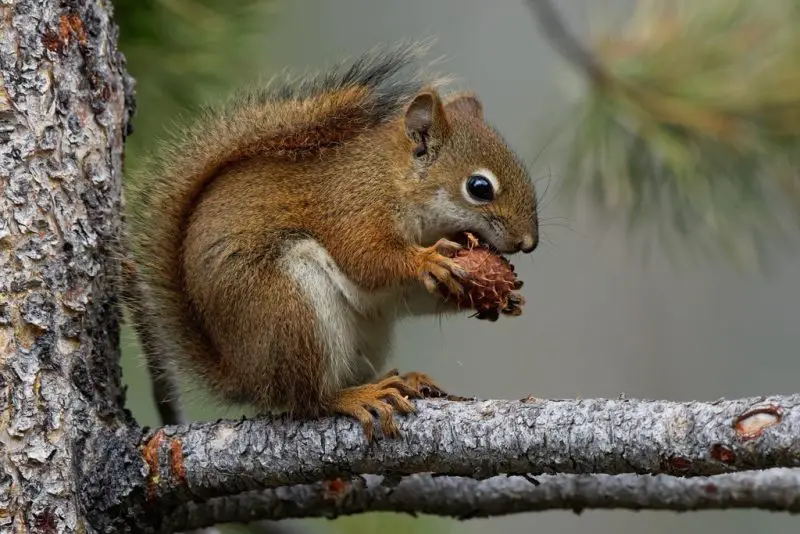
The Red Squirrel is a small, energetic tree squirrel found in Utah’s coniferous forests, especially in mountainous regions. It is easily recognized by its reddish-brown fur, white underbelly, and prominent white eye ring. Its tail is fluffy but not as long or broad as that of the Eastern Fox Squirrel. Adults measure around 11 to 14 inches in total length and weigh between 5 and 9 ounces.
This squirrel is highly territorial and vocal, often chattering loudly to warn intruders away from its domain. It builds large nests in tree branches or tree hollows and caches food in middens — piles of cones, nuts, and seeds — to survive harsh winters. Red Squirrels remain active year-round, even in snowy conditions.
Their diet is centered around conifer seeds, particularly from spruce and fir trees, but they also eat mushrooms, buds, berries, and bird eggs. They are commonly found in high-elevation forests throughout Utah, such as the Uinta Mountains and the Wasatch Range. They avoid deserts and open sagebrush plains, preferring dense, cool woodlands.
Fun fact: Red Squirrels are known to dry out mushrooms by hanging them on tree branches — essentially creating “mushroom jerky” to store for winter!
Eastern Fox Squirrel (Sciurus niger)

The Eastern Fox Squirrel is the largest tree squirrel in Utah and is characterized by its reddish-orange belly, gray-brown back, and long, bushy tail. It can grow up to 20 to 27 inches in total length and weigh over 2 pounds. Despite its name, this species is native to eastern North America but has been introduced and established in parts of Utah.
These squirrels are tree dwellers, commonly seen foraging on the ground or leaping from branch to branch in urban parks, farmlands, and deciduous forests. They build leafy nests high in trees and also take shelter in tree cavities. Active year-round, they are often observed during daylight hours searching for food or burying nuts for later use.
Fox Squirrels primarily feed on acorns, walnuts, fruits, grains, and even corn, making them frequent visitors to agricultural lands. In Utah, they are most common along the Wasatch Front and in urban areas like Salt Lake City, where they have adapted well to human-altered environments.
Fun fact: Despite being non-native to Utah, Eastern Fox Squirrels have become so common in some cities that they’re often mistaken for a local species.
Golden-mantled Ground Squirrel (Callospermophilus lateralis)
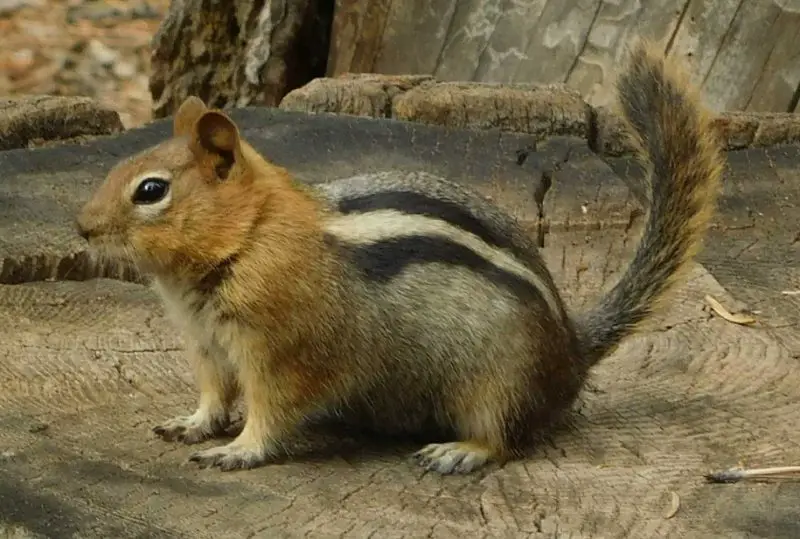
The Golden-mantled Ground Squirrel resembles a chipmunk but is noticeably larger and lacks facial stripes. It has a golden or reddish-brown “mantle” across its shoulders and neck, with two black stripes down its sides bordered by white. Adults grow to about 9 to 12 inches long and weigh 5 to 10 ounces.
These ground squirrels are diurnal and solitary, spending much of their time foraging for food or sunning themselves on rocks. They dig extensive burrows beneath logs, tree roots, or boulder piles and hibernate during the cold months. They’re often spotted darting across hiking trails or sitting upright to keep watch.
Golden-mantled Ground Squirrels eat seeds, berries, insects, and occasionally fungi. They are common in Utah’s mountain forests and rocky slopes, especially at mid to high elevations such as Bryce Canyon and the Wasatch Mountains. Unlike tree squirrels, they are not skilled climbers and spend nearly all their time on the ground.
Fun fact: These squirrels will sometimes “play dead” when threatened, lying motionless until the danger passes.
Uinta Ground Squirrel (Urocitellus armatus)
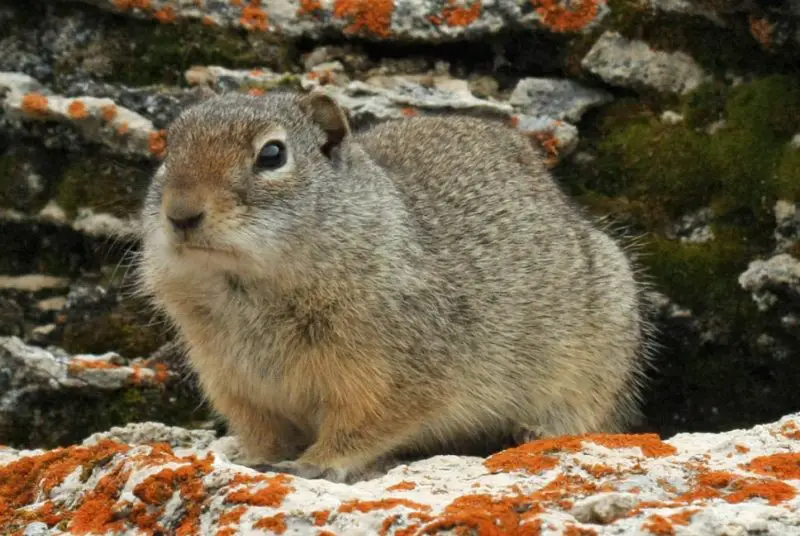
Endemic to parts of the Intermountain West, the Uinta Ground Squirrel is a species unique to regions like northern and central Utah. It has a short, stocky body with grayish-brown fur and a short tail. Adults grow to about 11 to 12 inches long and weigh between 8 and 14 ounces.
These squirrels are among the earliest risers in spring, emerging from hibernation as soon as the snow melts. They are active during the day and live in colonies with overlapping burrow systems in open meadows, sagebrush flats, and grassy fields. By late summer, they begin retreating to their burrows and remain underground for up to 8 months.
Uinta Ground Squirrels feed on grasses, seeds, flowers, and the occasional insect. They are especially prevalent in places like the Uinta Basin, Cache Valley, and grassy clearings throughout northern Utah. Their short active season makes them less visible than other squirrels during the year.
Fun fact: These squirrels are extremely vocal and use a series of chirps and whistles to alert others in their colony to potential danger — kind of like a prairie dog’s warning system
Least Chipmunk (Neotamias minimus)
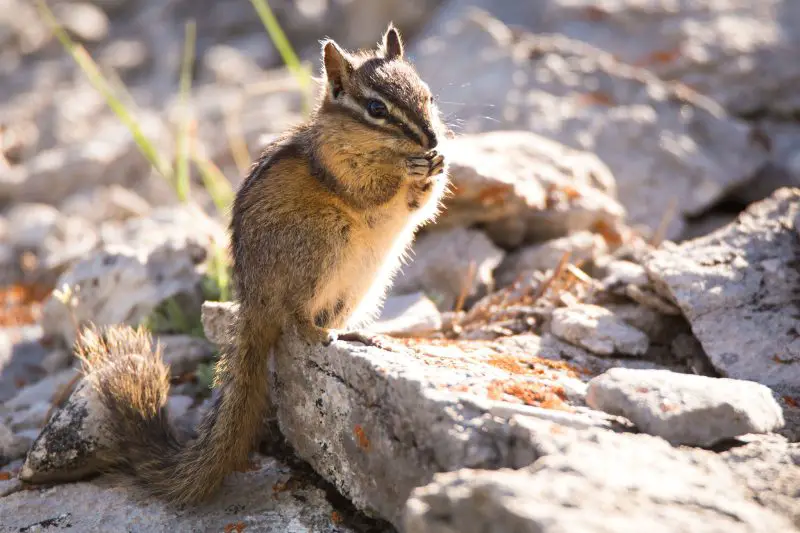
The Least Chipmunk is the smallest of all chipmunks in North America and a common sight in Utah’s forests, shrublands, and rocky outcrops. It has a slender body with tan to grayish-brown fur, accented by five distinct dark stripes running along its back and sides. A white stripe above and below the eyes makes it easily distinguishable from similar species. Adults measure about 7 to 9 inches long, including their tail, and weigh around 1 to 1.5 ounces.
Agile and alert, these chipmunks are active during the day and are especially busy in the early morning and late afternoon. They’re excellent climbers and can often be seen scurrying up low shrubs or small trees in search of food. They spend most of the year preparing for winter by storing seeds and food in underground caches. During winter, they go into a light hibernation, periodically waking to feed.
Their diet is omnivorous and consists of seeds, berries, nuts, fungi, and insects. Least Chipmunks inhabit a wide range of habitats, including sagebrush flats, open forests, and rocky slopes in both low and high elevations. In Utah, they’re common in areas like the Uinta Mountains and the Wasatch Plateau.
Fun fact: Least Chipmunks can carry food in their cheek pouches that are nearly the same size as their heads, allowing them to transport large amounts back to their burrows in one trip!
Cliff Chipmunk (Neotamias dorsalis)
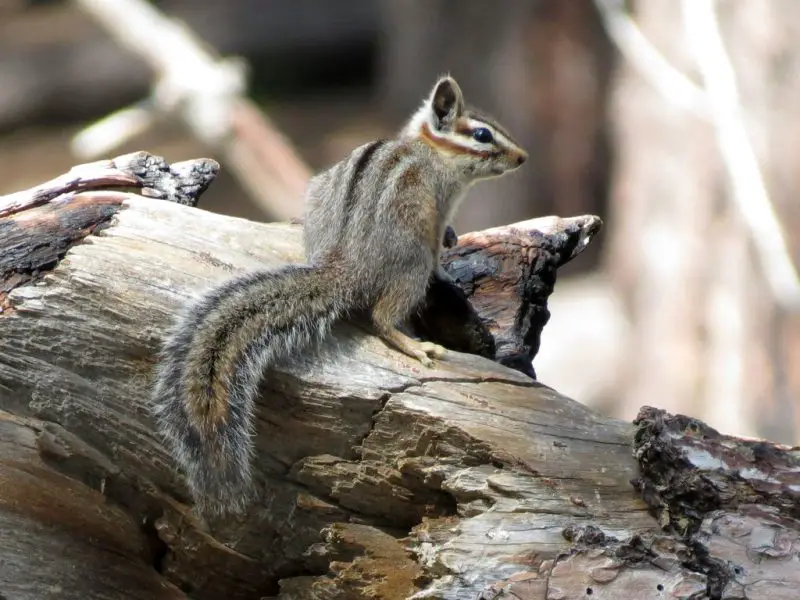
The Cliff Chipmunk is a sleek, agile species that thrives in Utah’s rocky cliffs, canyon walls, and high desert mesas. It has a grayish-brown body with light undersides and several faint black and white stripes along its back. Its tail is long and bushy, often held erect when running. Adults grow to about 8 to 10 inches in total length and weigh between 2 and 3 ounces.
Unlike more terrestrial chipmunks, the Cliff Chipmunk prefers vertical terrain and is often seen bounding across boulders, ledges, and rocky crevices with ease. It is solitary by nature and spends much of its time foraging alone. These chipmunks are diurnal and remain active even in cooler temperatures, though they retreat to burrows in harsh winter conditions.
They primarily consume seeds, nuts, berries, and cactus fruit, and will also eat small insects when available. In Utah, they are most often spotted in the southern part of the state, particularly in Zion National Park, the Grand Staircase–Escalante region, and other rugged canyonlands.
Fun fact: Cliff Chipmunks are expert climbers and can scale steep rock faces with ease, often nesting in cracks or crevices where predators cannot reach them.
Uinta Chipmunk (Neotamias umbrinus)
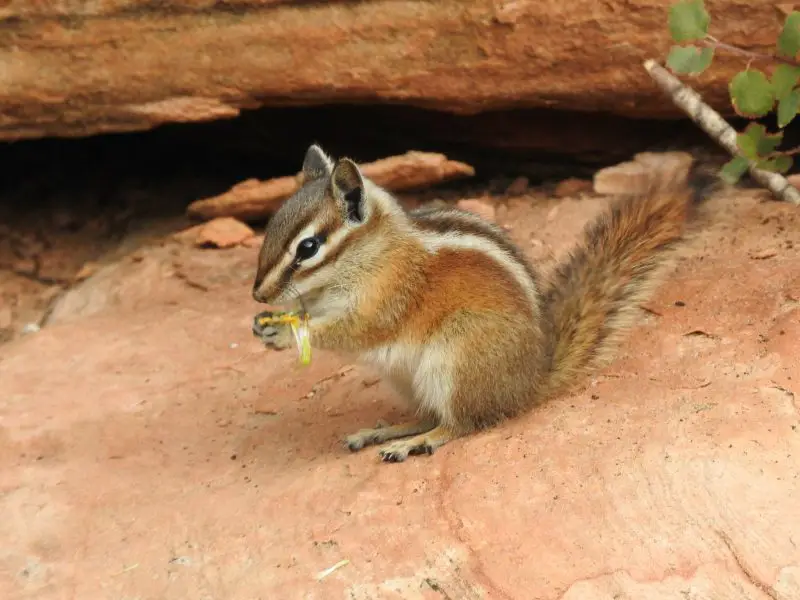
The Uinta Chipmunk is a high-elevation species known for its bold striping and colorful coat. It has reddish-brown to dark gray fur with three bold black stripes separated by two white stripes along its back. Its face is marked with additional dark and light stripes, and its tail is bushy and multicolored. Adults measure 8 to 10 inches long and weigh around 2 to 3 ounces.
This chipmunk is found in coniferous forests, subalpine meadows, and rocky forested slopes throughout Utah’s mountain ranges. It is diurnal and spends much of the day foraging, climbing shrubs, and navigating fallen logs. Uinta Chipmunks are excellent climbers but also create burrows beneath logs or stumps for nesting and storing food.
They feed on seeds, pine nuts, fruits, insects, and fungi, and play an important ecological role by dispersing seeds and spores. Their range in Utah includes the Uinta Mountains, the Wasatch Range, and higher parts of central and southern Utah. They hibernate during winter but occasionally wake to snack on stored food.
Fun fact: Uinta Chipmunks can make rapid trilling alarm calls that alert other chipmunks and squirrels to nearby predators like hawks or foxes.
Yellow-bellied Marmot (Marmota flaviventris)
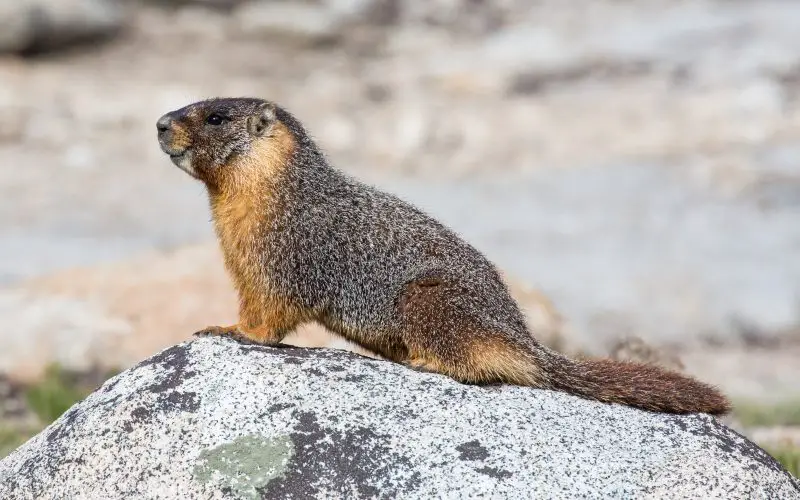
Though not a true squirrel, the Yellow-bellied Marmot belongs to the squirrel family (Sciuridae) and is one of the largest members of this group in Utah. It has a robust, bulky body with yellowish-brown to rusty fur and a lighter, almost golden belly. Adults typically measure 18 to 27 inches long and weigh between 5 and 11 pounds, depending on the season.
Yellow-bellied Marmots are highly social and often live in colonies within high-altitude meadows, talus slopes, and rocky outcroppings. They are most active in the morning and late afternoon, spending much of the rest of the day basking on warm rocks. Marmots hibernate for more than half the year, typically from September to April.
Their herbivorous diet includes grasses, flowers, forbs, and other alpine plants. In Utah, they are commonly found in mountainous areas like the Wasatch and Uinta ranges and the La Sal Mountains in the southeast. Their loud, high-pitched whistle has earned them the nickname “whistle pig.”
Fun fact: Yellow-bellied Marmots can double their body weight during summer to prepare for their long winter hibernation.
Northern Flying Squirrel (Glaucomys sabrinus)
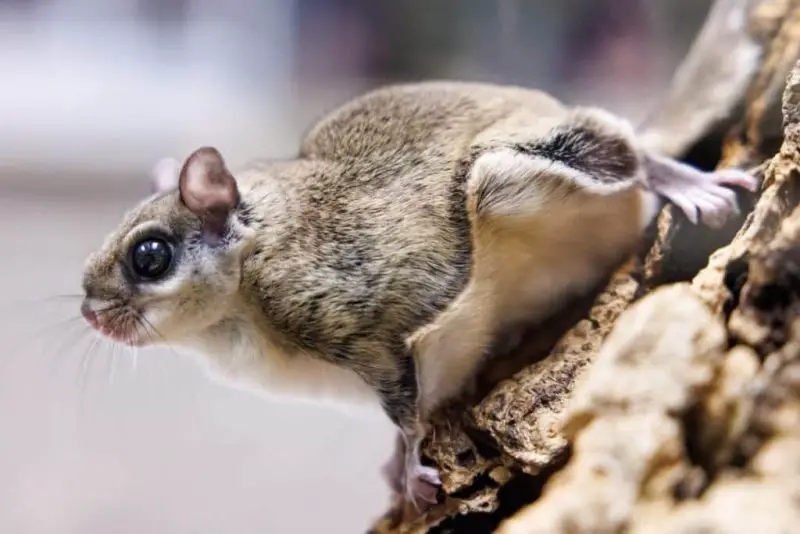
The Northern Flying Squirrel is a rare and elusive nocturnal squirrel species found in the dense forests of northern Utah. Despite the name, it doesn’t truly fly but glides using a membrane called a patagium, which stretches between its wrists and ankles. Its soft fur is grayish-brown above and white below, and it has large black eyes adapted for night vision. Adults measure 9 to 12 inches in length, including the tail, and weigh about 3 to 5 ounces.
Flying squirrels are strictly nocturnal and are rarely seen by humans. They live in old-growth coniferous and mixed forests, nesting in tree cavities or abandoned woodpecker holes. They glide silently from tree to tree in search of food and are incredibly agile in the air, sometimes gliding over 100 feet in a single leap.
Their diet consists of fungi (especially truffles), lichens, seeds, berries, and sometimes bird eggs or insects. In Utah, they are found in limited areas with mature forest cover, particularly in the northern mountains and isolated patches of suitable habitat. Habitat fragmentation makes them increasingly vulnerable.
Fun fact: Northern Flying Squirrels play a critical role in forest ecosystems by dispersing truffle spores, which help trees absorb water and nutrients through symbiotic fungi.
FAQs About Squirrels in Utah
What types of squirrels can be found in Utah?
Utah is home to a variety of squirrels, including both tree and ground-dwelling species. Some of the most commonly found squirrels include the Rock Squirrel, Red Squirrel, Eastern Fox Squirrel, Golden-mantled Ground Squirrel, and Uinta Ground Squirrel. Other species like chipmunks and even Northern Flying Squirrels can also be spotted in suitable habitats.
Are flying squirrels found in Utah?
Yes, the Northern Flying Squirrel (Glaucomys sabrinus) is found in Utah, but it is rare and primarily inhabits dense, mature coniferous forests in the northern parts of the state. They are nocturnal and elusive, so sightings are uncommon.
Where are squirrels most commonly seen in Utah?
Squirrels in Utah are commonly seen in a variety of environments, including urban parks, mountain forests, rocky canyons, and desert scrublands. Tree squirrels like the Eastern Fox Squirrel prefer wooded and suburban areas, while ground squirrels and chipmunks are often seen in open meadows and rocky slopes.
What do squirrels in Utah eat?
Squirrels in Utah have a diverse diet depending on the species. Common foods include seeds, nuts, berries, fruits, fungi, insects, and even small vertebrates or bird eggs. Some species, like the Red Squirrel, also feed heavily on conifer seeds and mushrooms.
Do squirrels hibernate in Utah?
Many ground-dwelling squirrels in Utah, such as the Uinta Ground Squirrel and Yellow-bellied Marmot, hibernate during the winter months. Tree squirrels like the Red Squirrel and Eastern Fox Squirrel do not hibernate but stay active year-round, relying on cached food supplies.
Are any squirrel species in Utah considered invasive?
The Eastern Fox Squirrel (Sciurus niger), although not native to Utah, has established populations in urban areas such as Salt Lake City and the Wasatch Front. While not aggressively invasive, it competes with native species and may displace them in some regions.
Are squirrels protected by law in Utah?
In general, squirrels are considered non-game wildlife in Utah. However, certain restrictions may apply depending on the species and location. It’s best to consult the Utah Division of Wildlife Resources before attempting to trap, relocate, or hunt any wildlife.
Can squirrels carry diseases?
Yes, squirrels can carry diseases such as tularemia, leptospirosis, and parasites like ticks or fleas that may spread illness. However, they rarely pose a significant threat to humans unless handled or provoked. It’s always wise to observe wildlife from a distance.
What’s the difference between chipmunks and squirrels?
Chipmunks are actually a type of ground squirrel and are typically smaller with distinct facial stripes. Tree squirrels, like the Red or Fox Squirrel, have larger bodies and bushy tails, while ground squirrels and chipmunks tend to be more slender and live in burrows.


